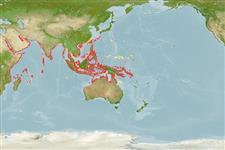>
Eupercaria/misc (Various families in series Eupercaria) >
Lutjanidae (Snappers) > Lutjaninae
Etymology: Lutjanus: Malay, ikan lutjan, name of a fish.
More on author: Peters.
Environment: milieu / climate zone / depth range / distribution range
экология
морской; пресноводный; солоноватоводный ассоциированный с рифами; пределы глубины 5 - 20 m (Ref. 9710). Tropical; 30°N - 18°S, 31°E - 165°E (Ref. 55)
Indo-West Pacific: Red Sea and East Africa to the Solomon and Mariana islands.
Length at first maturity / Size / Вес / Возраст
Maturity: Lm 20.1, range 12 - ? cm
Max length : 35.0 cm TL самец/пол неопределен; (Ref. 55); common length : 20.0 cm TL самец/пол неопределен; (Ref. 55)
колючие лучи спинного плавника (общее число) : 10; членистые (мягкие) лучи спинного плавника (общее число) : 13 - 14; колючие лучи анального плавника: 3; членистые (мягкие) лучи анального плавника: 7 - 9. This species is distinguished by the following characters: body moderately deep; greatest depth 2.5-3.0 in SL; preopercular notch and knob poorly developed; vomerine tooth patch triangular, with a medial posterior extension; gill rakers of first gill arch 6-7 + 10-14 - 16-21; caudal fin truncate to slightly emarginate; scale rows on back parallel to lateral line. Colour of back and upper sides dark brown, lower sides and belly whitish with a silver sheen; usually a series of 4-5 narrow yellow stripes on the sides below the lateral line; a distinct round, black spot on the back below the posterior part of the spinous portion of the dorsal fin (Ref. 9821, 90102).
Adults inhabit very shallow coastal habitats, often in large schools near freshwater run-offs (Ref. 48635). Juveniles often intertidal (Ref. 48635); over sand, silt, or coral rubble bottoms, occasionally in mangrove-lined streams and estuaries (Ref. 9821) They may enter freshwater to feed (Ref. 245); on small fish and invertebrates (Ref. 5213). This is a small species commonly utilized in subsistence fisheries and also seen in markets. Caught mainly with handlines, traps, and gill nets and are marketed mostly fresh (Ref. 9821).
Life cycle and mating behavior
Maturities | размножение | Spawnings | Egg(s) | Fecundities | личинки
Allen, G.R., 1985. FAO Species Catalogue. Vol. 6. Snappers of the world. An annotated and illustrated catalogue of lutjanid species known to date. FAO Fish. Synop. 125(6):208 p. Rome: FAO. (Ref. 55)
Статус Красного Списка МСОП (Ref. 130435)
Угроза для людей
Harmless
Использование человеком
рыболовство: не имеет хозяйственного значения
дополнительная информация
инструменты
Специальные отчеты
Скачать в формате XML
ресурсы в Интернет
Estimates based on models
Preferred temperature (Ref.
123201): 25.9 - 29.3, mean 28.6 °C (based on 2891 cells).
Phylogenetic diversity index (Ref.
82804): PD
50 = 0.5000 [Uniqueness, from 0.5 = low to 2.0 = high].
Bayesian length-weight: a=0.01622 (0.01048 - 0.02510), b=2.95 (2.83 - 3.07), in cm total length, based on LWR estimates for this species & Genus-body shape (Ref.
93245).
Trophic level (Ref.
69278): 3.6 ±0.53 se; based on food items.
Generation time: 4.4 ( na - na) years. Estimated as median ln(3)/K based on 2
growth studies.
устойчивость к внешним воздействиям (Ref.
120179): высокий, минимальное время удвоения популяции до 15 месяцев (Preliminary K or Fecundity.).
Fishing Vulnerability (Ref.
59153): Low vulnerability (19 of 100).
Nutrients (Ref.
124155): Calcium = 56.1 [33.6, 96.4] mg/100g; Iron = 0.49 [0.30, 0.85] mg/100g; Protein = 18.8 [17.3, 20.2] %; Omega3 = 0.137 [0.085, 0.225] g/100g; Selenium = 51 [28, 92] μg/100g; VitaminA = 153 [28, 664] μg/100g; Zinc = 0.563 [0.396, 0.837] mg/100g (wet weight);
